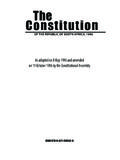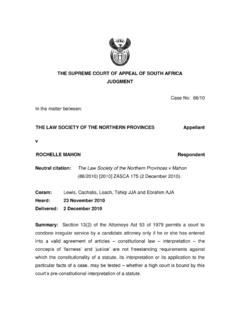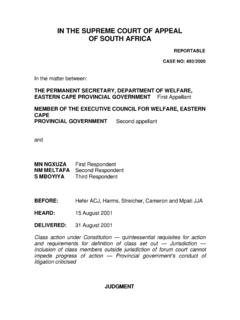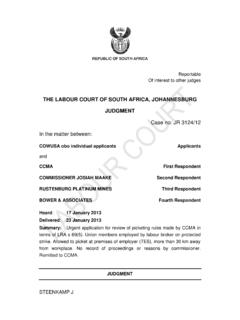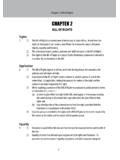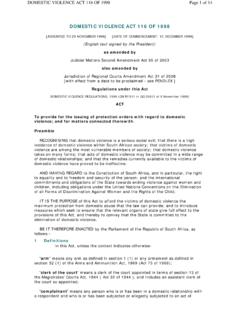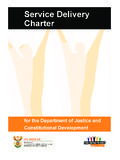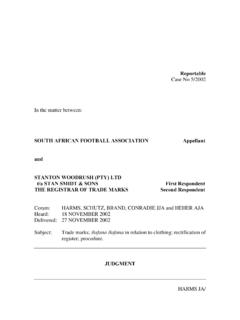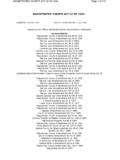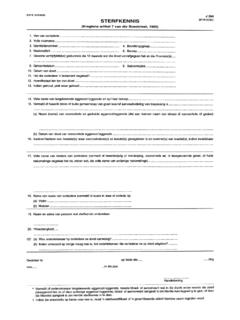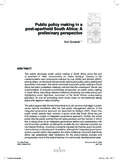Transcription of Measuring poverty in South Africa - Justice Home
1 Measuring poverty in South Africa Methodological report on the development of the poverty lines for statistical reporting Technical Report D0300. November 2008. your leading partner in quality statistics Measuring poverty in South Africa : Methodological report on the development of the poverty lines for statistical reporting Technical report D0300. Statistics South Africa November 2008. Foreword This report presents the work of Statistics South Africa on piloting a monetary poverty measure in the form of poverty lines. The approach followed is that of absolute poverty measurement. In view of the multi-dimensionality of poverty , statistical agencies make deliberate choices to use one or other method.
2 Generally, statistical agencies that attempt to measure poverty predominantly use money-metric measures because of their well-developed methodologies. This work represents another step in creating an informed society. The development of these poverty lines will enable stakeholders and policy partners to focus on the dynamics of the poverty profile and to guide discussion and debates informed by a standard poverty measure. The poverty lines presented here, will be piloted in the period leading to 2014, when another review will be undertaken. During this period, Statistics South Africa will continue to engage with stakeholders on broader poverty measurement in various fora.
3 Although, this is a technical report, it has been written with a lay audience in mind to ensure better accessibility. Further reports in the series Measuring poverty in South Africa will present additional details on the subject- matter. We welcome comments and suggestions on this discussions on our website at We want to thank all participants in the various fora where preliminary reports were presented, including NEDLAC partners. P J Lehohla Statistician General 2. 1. Introduction poverty alleviation and the elimination of inequalities created during apartheid lie at the centre of development policy in post-apartheid South Africa .
4 This commitment is reflected in the various anti- poverty policies and programs developed, and implemented to meet the objectives of the Reconstruction and Development Program (RDP) of 1994. Under the RDP umbrella, poverty alleviation was addressed from a multi-dimensional perspective. This is in keeping with the understanding that poverty is multi-dimensional and, that those living in poverty are vulnerable to deprivation in several dimensions. Since 2004, government has indicated its intention to establish a poverty line as the basis for presenting indicators of poverty in monetary dimensions (Government Programme of Action 2004, Budget Speeches 2005 2008).
5 This technical report presents the methodology followed to develop a set of three pilot poverty to be used by Statistics South Africa (Stats SA) in reporting monetary poverty statistics. A. poverty line is a monetary cut-off point below which a person is deemed to be poor. These pilot poverty lines are designed to assist the reporting of statistical information on poverty levels and poverty profiles for analytical work in a pilot phase leading up to 2014. As South Africa moves towards an integrated anti- poverty strategy, such statistics are required to understand the poverty situation and to assess progress in addressing monetary poverty .
6 In support of anti- poverty strategies, a poverty line measure provides statistical standards and a systematic approach to reporting monetary poverty indicators. These include indicators of poverty levels ( , the headcount index, poverty depth) and inequality indicators ( , decile shares, the Gini coefficient). When combined with non-monetary information on households and individuals ( , access to basic services, educational attainment), it is possible to obtain statistical profiles of non- monetary indicators for various poverty groups the poverty matrix is one such example. 3. The pilot poverty lines (PPL) presented in this report are designed for use alongside existing administrative poverty measures implemented by government departments and other public sector agencies.
7 These include social grants, means-tested financial assistance, and access to no-fee government services. It is also important to emphasise that the PPL do not replace or affect existing criteria for other poverty alleviation programmes, nor can they be used to determine wages or remuneration of any kind. The primary purpose of the PPL is to report statistics on poverty levels and profiles. This purpose is dictated by the methodology followed in their construction, and by the limitations imposed by the household expenditure they are based on. Structure of the report The report consists of 5 sections. The Section 2 presents the context for the poverty line approach.
8 Data sources and a methods overview are discussed in Section 3, and the detailed process for constructing the PPL is presented in Section 4. Section 5. concludes. 4. 2. Overview of the poverty line approach Background poverty is an important, universal human problem. This is evident from its position on the world development agenda (for instance, the Millennium Development Goals). To ensure credible, effective action in addressing in poverty and inequality, information on the poverty situation is required on a regular basis. Information of this type is key to the policy development cycle when evidence -based decision-making is practised in setting poverty reduction strategies (see Box 1).
9 Box 1: The role of statistics in evidence-based policy-making What is evidence-based policy-making? Evidence-based policy-making exists when policy decisions are based on careful and rigorous analysis using sound and transparent data. In recent years, the international community has focused increasingly on monitoring and evaluation as the areas where statistics should be used in support of policy-making. However, policy outcomes are crucially affected by the use of statistics and statistical procedures in upstream' stages of policy-making, such as issue recognition, programme design, policy choice and accurate forecasting as well as monitoring and evaluation.
10 Sound and transparent statistics are essential for effective policy-making a necessary part of the enabling environment for improving development outcomes. There is rarely a simple link between statistics and the adoption of a particular policy. Policy-makers often draw different policy conclusions from the same set of data, owing to differences in the type of analysis undertaken and /or to difference in value judgments about policy objectives. Why is evidence-based policy-making desirable? Evidence-based policy-making is the only way of taking public policy decisions which are fully consistent with a democratic political process characterized by transparency and accountability.
